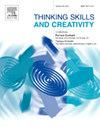50年后重新审视声音和文字的创造性思维测试:评估儿童创造潜力的声音刺激
IF 4.5
2区 教育学
Q1 Social Sciences
引用次数: 0
摘要
对儿童创造力的评估主要是使用视觉或语言性质的刺激和任务的工具。五十年后,我们重新审视了声音和文字创造性思维(TCSW)测试,声音和图像子测试,以分析声音刺激引起儿童心理图像的原创性,并通过“儿童创造力测试”(TCI)来了解其地形,并将其与视觉-具象创造潜力进行比较。该研究涉及310名西班牙学童(4-12岁)。使用混合方法,将两种工具(TCSW和TCI测试)的结果根据性别和教育阶段进行关联和分析。研究还考察了新颖性/复杂性和渐进式热身对原创性的影响。最后,对声音刺激诱发的3720个心理图像进行了表征。结果显示,在两种工具中获得的分数之间存在微弱但显著的正相关。性别与创造潜力水平没有关系。根据教育阶段,低年级学生的平均分数明显更高。考虑到性别和教育阶段,在最原始的回答中,在最常见的图像和特定的概况中发现了重叠的类型学。声音刺激的新颖性/复杂性影响图像的原创性,而渐进式热身的效果取决于刺激的性质。对答复的分析表明,交通工具是最经常出现的类别。根据性别(例如,战争声音)和教育阶段(例如,动物),发现了反应的显著差异。本文章由计算机程序翻译,如有差异,请以英文原文为准。
Revisiting the Thinking Creatively with Sounds and Words test 50 years later: Sound stimuli for assessing creative potential in childhood
The assessment of children's creativity is dominated by instruments that use stimuli and tasks of a visual or linguistic nature. Fifty years later, we revisited the Thinking Creatively with Sounds and Words (TCSW) test, Sounds and Images subtest, to analyse the originality of the mental images evoked by sound stimuli in children and to know their topography, compared with the visual-figurative creative potential through the ‘Test de Creatividad Infantil’ [Children's Creativity Test] (TCI). The study involved 310 Spanish schoolchildren (4–12 years old). Using a mixed methodology, the results of both instruments (TCSW and TCI tests) were correlated and analysed according to gender and educational stage. The impact on originality of novelty/complexity and a progressive warm-up was also examined. Finally, 3720 mental images evoked from the sound stimuli were characterised. The results show weak but significant positive correlations between the scores obtained in both instruments. Gender showed no relationship with the level of creative potential. According to the educational stage, mean scores were significantly higher in younger students. Considering gender and educational stage, overlapping typologies were identified in the most frequent images and specific profiles in the most original responses. The novelty/complexity of the sound stimuli influenced the originality of the images, whereas the effect of the progressive warm-up depended on the nature of the stimulus. The analysis of the responses showed that means of transportation was the most recurrent category. Significant differences in the responses according to gender (e.g., war sounds) and educational stage (e.g., animals) were identified.
求助全文
通过发布文献求助,成功后即可免费获取论文全文。
去求助
来源期刊

Thinking Skills and Creativity
EDUCATION & EDUCATIONAL RESEARCH-
CiteScore
6.40
自引率
16.20%
发文量
172
审稿时长
76 days
期刊介绍:
Thinking Skills and Creativity is a new journal providing a peer-reviewed forum for communication and debate for the community of researchers interested in teaching for thinking and creativity. Papers may represent a variety of theoretical perspectives and methodological approaches and may relate to any age level in a diversity of settings: formal and informal, education and work-based.
 求助内容:
求助内容: 应助结果提醒方式:
应助结果提醒方式:


